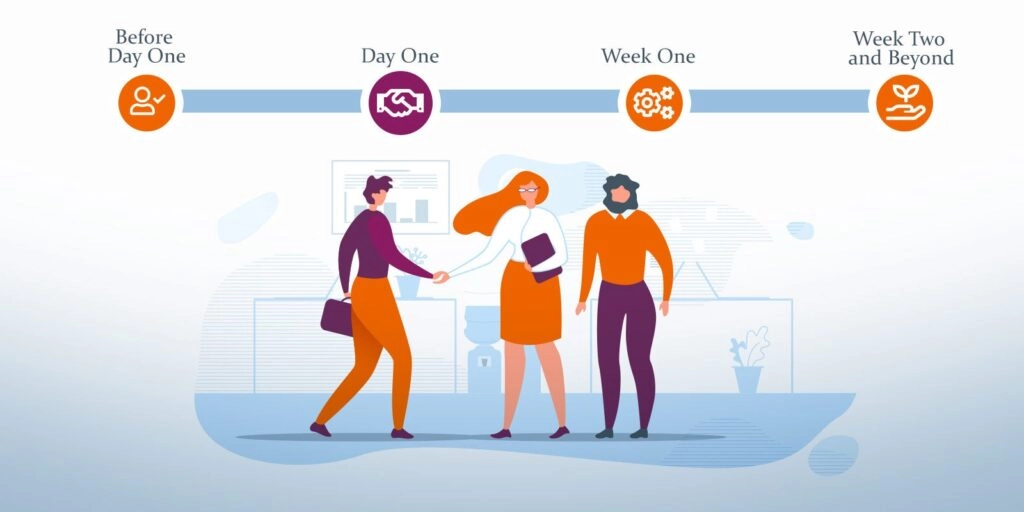Activities, Conversations and Best-Practices For Getting Your New Employee Engaged Quickly
You’ve just hired a new employee. Great! Now what? Hiring new employees is an exciting time – you’re expanding your team, your department’s capacity increases, and your staff gets to forge new relationships. When we bring on a new staffer, though, making a good impression is critical for creating an awesome new hire experience. If they left another job for this one, a good first impression reassures them they made the right choice. On the flip side, a bad first impression may make them question their decision. Additionally, getting new employees up to speed quickly can be tough and can take a lot of your time just to get them to the point where they can truly contribute. So, how do you give a new hire a good first impression? What activities should you plan during their first days and weeks on the job? And how can you accelerate a new employee’s learning curve once they’ve joined your team? Let’s review a manager’s checklist for hiring new employees to ensure they get a great integration into your team.A New World Brings New Challenges for Hiring Managers
For the first time in a long time, I’ve been hiring new employees. In fact, it’s been so long since I have hired someone that I’ve felt rusty, almost like I had forgotten what to do when a new employee joins the team. The last time I hired someone was in 2019 – before COVID, before the shift to almost entirely virtual work, and back when I had an office full of employees who new hires could lean on to ask basic questions. In addition to my personal rustiness, I found myself onboarding new employees into a very different workplace following the past two years of COVID. As companies have shifted heavily – if not permanently – to virtual work, basic things like hiring are dramatically more difficult. To give you an idea of these changes, here are just some of the challenges and unexpected road blocks we encountered along the way. New IT Processes – Getting IT access to standard tools my employees needed was different from just a year ago thanks to so many people going remote. Getting new employees access was a trial and error activity and we just had to figure things out on the fly. Global Supply Chain Shortages – Particularly with IT equipment, getting basic things like computers and monitors is not what it used to be. In some cases, my new employees had to be issues refurbished machines until new hardware could be acquired. Bringing People Into a Virtual Team – The last time I hired someone, in 2019, I had an office full of people who could be called up to help bring the new hire up to speed, mentor them, watch over their shoulder, etc. While I’ve managed virtual teams many times, the concept of ‘remote work’ has changed dramatically in the past 5 years. Continued Policy Changes – People are doing their best despite the challenges of a global health crisis. However, ongoing changes to guidance and regulations surrounding things like vaccinations, quarantine requirements, masks and everything else have made it difficult to communicate what employees need to do at any given time. Difficulty Putting Myself in Their Shoes – In truth, I’ve been with the firm for a while. Meaning, I know how the organization functions, who makes decisions, how different teams work together, etc. As a result, it is difficult to know what it’s like coming into the organization from the outside and what questions or concerns people have. Of course, nothing was insurmountable, but everything took effort. As a result, here is a my checklist for what to do during a new hire’s first few weeks on the job.
A Manager’s Onboarding Checklist for New Employees
1. Get the IT Stuff Setup Ahead of Time
To start, let’s talk about technology. If an employee has to wait days or weeks to get a fully functioning computer to get their job done, not only will it make a bad first impression, but it’s also just a loss of productivity. Between getting computers setup, to ordering monitors, to granting access to important folders and systems, the more you can do before the employee shows up, the better. With my recent experience, our IT setup has changed so much in the last few years – little by little – that getting everything my new employees needed setup in one shot was quite difficult. Added to the complications were the global chip shortage – getting new IT equipment simply is not what it was a few years ago.2. Before They Arrive, Prepare an Onboarding Schedule
By no means do you need or want a schedule for every hour of the new hire’s first few weeks. However, putting together a well-constructed plan to navigate their first days and weeks on the job will help you keep organized as well as give the new employee a roadmap for getting started. An onboarding schedule should include prescheduled times for:- Meetings with important stakeholders
- Dedicated time for completing required trainings
- Face time with project leaders to get up to speed and ask questions
- Introductions with functional leaders to get to know the organization
3. Setup Their Workspace in Advance
Giving your employee a new home that makes them feel welcome and lets them know you are eager for them to start. Take a few minutes to prepare a workspace before they arrive. To setup your new employee’s workspace, here are a few suggestions.- Order a nameplate
- Clean the desk and drawers
- Hookup the phone, monitors and docking station
- Post a ‘Welcome’ sign with their name & title that colleagues will notice
- Gather some basic office supplies
4. Make Introductions
Nothing is more uncomfortable for a new employee than showing up and sitting down in their cubicle, surrounded by people they don’t know. Are they teammates? Are they people they’ll even interact with? Be a good host and introduce the new hire to the team. Briefly explain how your new hire will work or collaborate with the people they meet to help your new employee get to know their new colleagues. When possible, identify points of common interest between them – hometown, school, personal interests.5. Assign a Peer Mentor
Let’s face it – asking the boss questions can sometimes be a little uncomfortable for your employees, especially about basic things. It’s much easier for a new hire to ask their cubicle mate or their peer than it is to ask you. To overcome this, nominate one employee to serve as your new hire’s peer mentor, or buddy. Align with the buddy ahead of time to ensure the new hire has a smooth transition. Explain to the buddy what you expect, what the new hire will be working on and what you’d like the buddy to focus on as part of supporting the new hire’s transition. What makes a good buddy for a new employee?- Someone who has the experience to help the new hire overcome common roadblocks.
- A resourceful employee who can help provide guidance and support when you are not available.
- An employee who is relatable to the new hire (such as same school, background, or assigned the same project, etc.).
- An employee who will demonstrate and reinforce the right behaviors of professional conduct.
- Someone whose own professional growth could benefit from developing leadership and supervisory skills.
6. Publish an Announcement
As part of your employee’s first week on the job, draft up and publish an announcement to the broader organization. Include a brief summary of the employee’s background, a description of their new role and responsibilities, and a photograph so people can recognize them. Create a standard template such that you can use it for future new hires.7. Review an Organizational Chart
During their first week or two, spend time with your new employee walking through the organizational chart. While absorbing all the names in one sitting is unlikely and not critical, reviewing your organization’s structure will help give your new employee an initial understanding of what the organization looks like, the various teams and departments, and ultimately who does what. In other words, reviewing the organizational structure helped them understand where they fit. There’s a lot to learn and absorb when joining a new team. By helping your new employees understand how the organization works, you can accelerate their integration into their new role.8. Review the Annual Calendar
Employees can be hired at any point in the year. And, most organizations have some sort of generalized annual operating cycle. As a vehicle for getting your new employee acclimated, review the annual business cycle. This conversation doesn’t need to be extensive, as the employee will learn the process gradually, but an overview of where you are in the year when they hire in, and what is to come is always a helpful to employees just getting their bearings. Examples of annual activities you might want to review:- Performance management process
- Annual budget planning
- Merit or wage adjustments (raises)
- Strategic plan updates
- Standard Monthly, Quarterly and Annual reviews
9. Set a Schedule for Regular One on Ones
One on one meetings with your employees are the most direct communication you can have with your employees. In these meetings, you can get a sense of workloads, help remove roadblocks, provide feedback and identify any issues that need attention. They also give the employee some much needed face time with you, their busy boss. A basic employee one on one meeting agenda can look something like this:- Current status of projects
- Updates on performance goals
- Development interests and needs
- Issues and concerns
- Help needed
10. Discuss Your Expectations
Certainly, you don’t want to scare your new employee by outlining a lengthy list of stiff expectations and rules. After all, you want your new employee to be excited and not possibly regret his or her decision to join your team! But it is a good idea to give them a little insight into your management style, your work preferences and ultimately what is truly important to you. For them, they’re looking to know who they’re working for. Here are a few examples of things you might want to say, as they apply to yourself:- “I tend to keep people loaded up with work so there’s always something to do. I will assume you can handle it, but if you are struggling to keep up, it’s ok to speak up.”
- “We all get a lot of emails. Email is fine for normal activities, but if there’re something urgent or needs my immediate attention, please come see me and let’s talk about it.”
- “I like to keep a casual atmosphere in our department. All I care about is the job gets done, done well and on time. Sometimes that may mean we have to work longer hours, but we try to minimize that as much as we can.”
11. Review How Performance is Both Measured and Evaluated
One thing near and dear to anyone you hire is how they will be evaluated at the end of the year. After all, their performance will directly link to things like wage increases, promotion opportunities and new roles. While your Human Resources people may do this as part of a standard new hire training, it’s important to internalize and personalize the conversation – your new employee works for you, not HR! Things to include as part of this discussion:- Measurements
- Timing
- Goals
- Scoring System
12. Establish Some Initial Goals and Objectives
An excellent follow-up to the performance management discussion is kicking things off with near-term goals. New employees are always eager to make an impact. To give your new staffer some initial direction and a way to contribute, assign some starter tasks even if it’s just initial busywork. To help provide some initial direction, here are a few things you might want to discuss with your new employee:- Initial performance goals
- Initial assignments
- Supporting a project that needs help
- Creating or revising a new hire guide
13. Let them Know What to Expect in Coming Day and Weeks
Rarely at the end of the first week is the new employee fully up to speed. Take a little time to outline their first month or two on the job. Examples of topics would include:- Additional trainings they will need to take
- Getting access to additional IT systems
- How you will introduce them to the customer
- Check-ins with leaders they should expect – you, your boss, the HR manager, etc.
14. Schedule Hands-On Shadowing Activities
A great way for your new employee to learn and get to know their new role is to give them time with other key resources in the organization. This can take the form of a ‘shadowing’ activity, in which the new employee follows someone around to learn a certain process or activity such that it helps the new hire do their job better. This could also be in the form of spending time with experts – product specialists, sales people, or factory employees – so that the new employee can ask questions directly to the people who can best answer them.15. Have the Employee Build a New Hire Guide Along the Way
Finally, back to my own recent experience, a significant gap we’ve had in our business has been the lack of procedures. Given the experience and struggles I was dealing with when it came to bringing my new employee up to speed, I asked my new hires – as part of their onboarding activities – to document challenges, tips, and instructions in order to help the next person who will eventually join our team. As was evident from my recent experience recruiting and hiring new employees, we did not have such a checklist or guide for new staff members. One of the initial assignments I’ve given my new staff members is to chronicle their lessons learned, steps they had to take at various points, and quick access links to useful information. Even if your organization does have a new hire guide, have your new employee revise it in order to make sure it’s as up to date as possible.
Guiding Your New Employee Through Their First Days on the Job
Getting back to the point where I’ve been able to hire new team members has been enjoyable. However, hiring is a busy time for everyone involved. As the manager, it’s ultimately on your shoulders to ensure the new hire’s experience is a positive one. While the process is never perfect, by preparing and remaining heavily engaged during their first few weeks, you can help your new employee settle into their organization well.Source: 15 Manager Tips for Creating an Awesome New Hire Experience (managersresourcehandbook.com)


